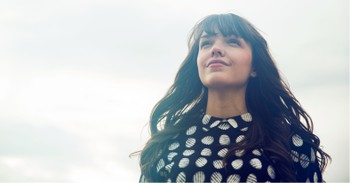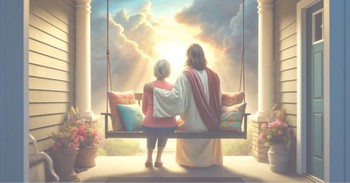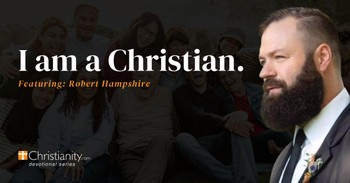
She was one of the most incredible missionary women ever. Her life seemed like one great adventure with God. Her mission began on her mother's lap. As a child, her mother taught her about Calabar, the deadly coast of Nigeria, known as "the white man's grave." Like other Scottish children, she donated her precious pennies to help the mission work. Eventually she asked the Presbyterian church to send her to Calabar, too.
In 1875, her answer came in the mail. "Dear Miss Slessor, I take great pleasure in informing you that the Board of Foreign Missions accepts your offer to serve as a missionary, and you have been appointed teacher to Calabar." Mary, a twenty seven-year old factory worker, rejoiced to read those words.
But could she go when her family needed her income from the factory? From the age of only eleven she had worked in the sweat shops of Dundee as a common mill hand, preparing jute and flax for the weavers. In time, she had become a skilled weaver herself, able to manage two sixty-inch looms at once, turning out ships' canvas, sacking, sheets, and cloth. While a little girl, and exhausted by her work, for she was "wee and thin and not very strong," Mary still made the most of her opportunities. She attended school when not working and learned reading, writing, arithmetic, geography, sewing, knitting, and a little music. If she was too tired to follow the arithmetic problems, the teacher punished her by making her stand during class. In winter, when the nights came early, she dodged drunks and thieves as she walked home in the dark to do her chores and face her father. And facing her father was not something to look forward to.
Her Drunken Dad
Mary's father, Robert Slessor, was an alcoholic. He probably felt useless, for the mills hired women and boys in preference to men, who had to be paid higher wages. When Robert came home violent, red-haired Mary stood up to him. To protect her from beatings, Mrs. Slessor shooed her out into the street, to wander crying until her father fell into a drunken sleep. But Mary learned to hold her own.
She was quick with her tongue. She described herself as a "reckless lassie" full of mischief, who ran barefoot, jumped, and climbed trees like a boy. She would never completely outgrow her tomboy practices. But one day an old widow gathered Mary and some friends around her hearth. Pointing to the fire blazing in it, she warned them that unless they repented and believed in Christ, their souls would "burn in the lowin' bleezin' fire for ever and ever!" The words startled Mary, and she turned to Christ.
After she became a Christian, Mary tried to help children whose lives were as bleak as her own. She held Bible classes to tell them of the friend she had found in Christ Jesus. She took classes of boys into the countryside for picnics and raced and played with them. Her behavior raised the eyebrows of people in the pews who always wanted things done "properly."
Some toughs did not want to hear what Mary had to say. They jeered and slung mud at her. Once they surrounded her while their leader whirled a lead weight around and around on a string, approaching closer and closer to her face. She stood without flinching, praying inwardly, but determined not to duck or run. The lead grazed her forehead, but she stood with steady eyes. The ringleader dropped the lead. "Its OK boys. She's game!" He made his whole gang attend meeting that night. With persistent effort she led many youngsters to Christ.
Off to Africa
On August 5, 1876 she sailed for Africa aboard the S. S. Ethiopia. When she arrived in Calabar Mary quickly learned about cruel gods carved of wood and stone. The Nigerians sacrificed humans to these gods. Mary put her own life on the line, trying to rescue slaves and women from death. She also fought against the practice of judging by ordeal. A person suspected of doing wrong might be forced to eat poison beans, or boiling oil might be poured over him. The gods were supposed to protect the innocent from harm, but of course they didn't. Every one tested by these methods was "guilty." Such cruelty infuriated Mary. When one man poured boiling oil on the hands of an eleven year old boy, she grabbed a scoop of the scalding liquid and chased the man to pour it on him to show him that he was not innocent either. Everyone laughed, except the poor boy who was still screaming in agony.
Another horror was the treatment of wives after the death of a husband. They were automatically suspected of witchcraft. A chicken was beheaded in front of each wife. Depending on how it flopped, the wife was pronounced guilty or innocent. The legs of the "guilty" wives were broken and the women thrown alive into their husband's grave. Ma Eme, a chief's sister, went through this ordeal. Her chicken declared her innocent, and she fainted from relief. After that, she often informed Mary secretly when ordeals were happening so that Mary could rescue the accused women.
Facing the Forces of Fear and Evil
The Nigerians enslaved and branded each other. Girls were fattened up to sell as slave wives. Slaves were expendable, and when a chief died, dozens were killed. Other evils included throwing unwanted babies into the bush to be nibbled by insects or gobbled by leopards. Twins were believed to be a great evil. One had the devil as its father, said the Nigerians, but since no one knew which one, both were buried alive or thrown into the forest. Their mother was driven away to die. The tribes fought and danced and got drunk. Sometimes they ate one another. Everyone lived in fear. A secret society known as the Egbo went around in masks and beat people. Once Mary chased a group of Egbo and tore off a mask.
Mary contracted malaria. She had to return to Scotland. On furlough she told church women about Calabar and many became interested in her work. Strangely, although Mary was very bold to talk to African chiefs, she was too shy to speak in front of men in Scotland's churches.
Single Mom with Many Kids
When she returned to Africa, Mary was allowed to work alone in Old Town. She liked her new freedom. For fun, she climbed trees. She ate when she felt like it and set her own work pace. Her house was soon full of orphans and twins that she rescued, fed, and cuddled.
One twin became so sick that Mary took her into the hills where it was cooler. She brought her other babies with her. A leopard entered her tent and seized a baby boy in its mouth. Mary grabbed a flaming stick and drove it into the leopard's face. The leopard dropped the boy and fled howling. Fortunately, the boy was not hurt.
While at Old Town, Mary ate African food and learned African ways. With simple medicines she cured sickness. When trade routes were cut off by a war, she secretly led men across the mission station at night so they could sell their goods. When Chief Okon asked her to visit Ibaka and teach his people about Christ, she was brought up river in an impressive war canoe with thirty-three oarsmen.
However, Mary again became ill and had to return to Scotland. When she recovered, she could not go directly back to Africa because her sister was dying. The last three members of Mary's family died within a year of each other. It was almost two years before Mary could return to Africa.
Up-Country
More than ever, she wanted to work up country. The mission board was afraid to send her alone, and other missionaries did not like to work with her because she lived a helter skelter life. Mary could not change her style, as it was so much part of her. And she knew that she always had to be ready to drop everything at a moment's notice to help where she was needed in order to save lives. Finally the mission gave in. On August 4th, 1888, Mary set out for Okoyong. The canoe landed near dusk. An eerie silence hung over the forest. No one met her. It turned out everyone was at a funeral. Mary had to find her way to a hut in darkness and pouring rain. To calm the fears of the children with her, she sang silly songs. "What is courage, but faith conquering fear?" she asked.
From then on, Mary worked alone, pushing further and further inland. Because Mary understood the people's customs so well, they brought their quarrels to her to settle. The British government made her a vice-consul with authority to judge. When the slave trade ended, the people of the countryside needed new income. Mary helped them make peace with the people on the coast so that they could trade palm oil in exchange for goods.
She made a major contribution in bringing an end to some of the worst ways. She grabbed women and took them to her house before they could be forced to drink poison. More than once she sat up all night, or even several nights, to protect slaves from execution. When the natives insisted on clinging to cruel practices, Mary asked the British to send an armed force into the interior to "palaver" with the chiefs. The expedition won a peaceful end to some of the evils. More importantly, Mary increasingly and widely helped the Africans recognize that lives were worth saving.
In 1914, she fell so sick that she was taken by canoe to the government hospital. She recovered for a few weeks but collapsed again in January. As she lay semi-conscious she whispered "O God, release me." She died January 13, 1915. She had not ended all evil practices, but she had an extraordinary influence for good over thousands of square miles of Africa.
Years after Mary's death, African women still reenacted the story of the time she drove off a hippopotamus by yelling and waving her umbrella. "God and one are always a majority," Mary often said.







